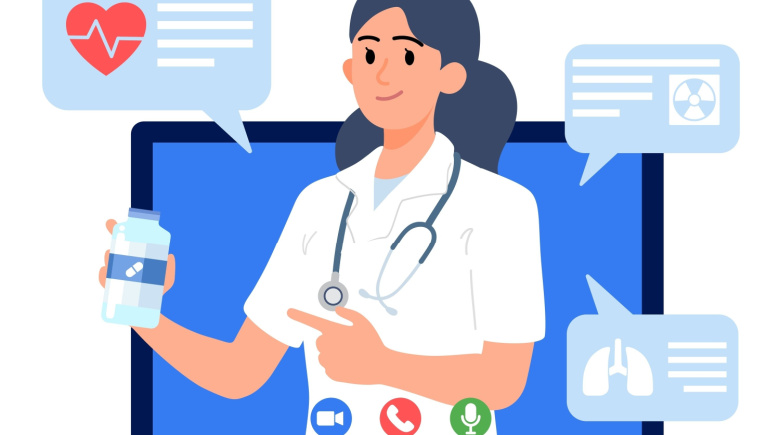The way we receive healthcare has changed a lot in the past few years. Telehealth has moved from a fringe service to the mainstream for millions now, thanks to improvements in digital technology and the COVID-19 pandemic, which sped up virtual solutions. Initially, it was a convenience for patients, but now it has been a lifeline for not just patients but doctors and healthcare systems as well. Telehealth is changing the game making care more available, shortening wait times, enhancing patient outcomes, and even assisting in addressing systemic challenges like provider shortages.
Why Telehealth Took Off (and Why It’s Here to Stay)
Telehealth is old news, though; it’s been here for decades on some level. But only recently did regulators, technology gaps, and skepticism from both providers and patients limit its use. That all changed with the pandemic. Due to social distancing rules, hospitals being overwhelmed, and infected persons being scared to visit in person, demand soared for anything virtual. Video visits, remote monitoring, and other digital health tools became necessities all of a sudden.
In a short time, health systems embraced telehealth platforms, insurers broadened coverage, and patients of all ages figured out how to video consult from home. What commenced as a reaction to an emergency has now become a typical provision. In fact, numerous providers now state that their practice cannot exist without it. The genie is out of the bottle and there’s no going back.
Improving Access to Care, Especially in Underserved Areas
Telehealth’s ability to provide healthcare access is one of its most powerful benefits. Rural areas and underserved cities frequently have limited healthcare providers. Taking a long drive, limited modes of transport, and lack of funds can inhibit people from availing timely care. With telehealth, patients can contact doctors, specialists, and mental health professionals from their smartphones or laptops—no traveling needed.
This ease of access can help in managing chronic disease, getting routine checkups, and mental health support. People who have mobility issues or jobs that can’t take time off find telehealth useful too. In simple words, it brings the doctor’s office to the patient, wherever they are.
The Technology Behind the Transformation
The increasing use of technology has brought about telehealth. The electronic health record (EHR) integration is when the video conferencing platform integrates with your electronic health record (EHR) system. Today, vital signs, glucose levels, heart rhythms, and more are monitored at home with smartwatches and fitness tracker devices. These tools give healthcare providers continuous information for a better way to care.
Further, mobile apps have helped patients take charge of their health by booking appointments, getting lab results, receiving medication reminders, and receiving personalized wellness tips. Technology is turning into a data-driven experience, and telehealth is at the forefront.
The Expanding Role of Telehealth in Mental Health Services
Although telehealth has facilitated access to different kinds of care, one of its most significant impacts is in the mental health area. More and more people are looking for therapy and psychiatric services, and because of virtual care, they are able to get it. People can easily access help with online counseling platforms and telepsychiatry services—this has reduced the stigma and hassle that often come with in-person visits.
People feel more at ease when they tell their problems from their homes, and mental health workers can help clients from a wider geographical area without needing to have an office in every town. The wait times are getting reduced with the greater access to patient customization and cultural response with early interventions, which are critical due to more severe mental health crises.
Challenges and Considerations: Not a Cure-All
Telehealth has many benefits; however, it may not be suitable for all situations. Healthcare providers and policymakers to wake up over its challenges. First, the digital divide remains a barrier. Due to a lack of reliable internet, updated devices, and digital literacy, not all patients can connect virtually.
The doctor’s office may offer remote visits, but some types of care still require a visit. There’s also the issue of privacy and data security. Telehealth platforms, though usually encrypted and compliant, can still be attacked and/or hacked, which can put your data at risk.
How Providers Are Adapting to the Virtual Model
Healthcare providers are learning to adopt the virtual care model with new trainings, workflows, and technologies. Clinics are turning to hybrid models, serving patients in person and via telehealth as needed. Doctors are being trained to strengthen their relationship and trust with patients, even through a screen.
To make virtual care easy and effective, practices are also rethinking scheduling, intake processes, and patient communications. Some providers are even purchasing remote patient monitoring kits to send home with their patients for dial-in use. Having remote patient monitoring kits sent to one’s home helps to not merely make a telehealth visit an in-person visit.
Telehealth and the Future of Personalized Medicine
The future of telehealth is likely to affect personalized medicine hugely as it continues to grow. With access to real time data, patient history, genetics, and behavior, it is easier to create treatments for patients. Picture a future where your smartwatch detects the early signs of sickness, sets off a telehealth appointment, and starts a treatment plan—all in hours.
Telehealth combined with artificial intelligence, big data, and genomics can offer interesting avenues for early detection, prevention, and personalized care. This is a movement from reacting to seeking towards wellness and preventiveness with telehealth.
Final Thoughts
Telehealth is not a passing trend; it represents a revolution in the delivery and thinking of patient care. Virtual care is transforming the healthcare system. It is making consultations easier in urban areas and ensuring improved care in areas with no access. Plus, mental health treatment is also easier. Although there are several challenges, there is definitely a push for telehealth.
Patients will start to see more flexibility in their care, along with enhanced accessibility and a greater level of personalization, because of advancing technology and providers embracing hybrid models. Healthcare is already here, just a click away, and its future is gleaming.
The way we receive healthcare has changed a lot in the past few years. Telehealth has moved from a fringe service to the mainstream for millions now, thanks to improvements in digital technology and the COVID-19 pandemic, which sped up virtual solutions. Initially, it was a convenience for patients, but now it has been a lifeline for not just patients but doctors and healthcare systems as well. Telehealth is changing the game making care more available, shortening wait times, enhancing patient outcomes, and even assisting in addressing systemic challenges like provider shortages.
Why Telehealth Took Off (and Why It’s Here to Stay)
Telehealth is old news, though; it’s been here for decades on some level. But only recently did regulators, technology gaps, and skepticism from both providers and patients limit its use. That all changed with the pandemic. Due to social distancing rules, hospitals being overwhelmed, and infected persons being scared to visit in person, demand soared for anything virtual. Video visits, remote monitoring, and other digital health tools became necessities all of a sudden.
In a short time, health systems embraced telehealth platforms, insurers broadened coverage, and patients of all ages figured out how to video consult from home. What commenced as a reaction to an emergency has now become a typical provision. In fact, numerous providers now state that their practice cannot exist without it. The genie is out of the bottle and there’s no going back.
Improving Access to Care, Especially in Underserved Areas
Telehealth’s ability to provide healthcare access is one of its most powerful benefits. Rural areas and underserved cities frequently have limited healthcare providers. Taking a long drive, limited modes of transport, and lack of funds can inhibit people from availing timely care. With telehealth, patients can contact doctors, specialists, and mental health professionals from their smartphones or laptops—no traveling needed.
This ease of access can help in managing chronic disease, getting routine checkups, and mental health support. People who have mobility issues or jobs that can’t take time off find telehealth useful too. In simple words, it brings the doctor’s office to the patient, wherever they are.
The Technology Behind the Transformation
The increasing use of technology has brought about telehealth. The electronic health record (EHR) integration is when the video conferencing platform integrates with your electronic health record (EHR) system. Today, vital signs, glucose levels, heart rhythms, and more are monitored at home with smartwatches and fitness tracker devices. These tools give healthcare providers continuous information for a better way to care.
Further, mobile apps have helped patients take charge of their health by booking appointments, getting lab results, receiving medication reminders, and receiving personalized wellness tips. Technology is turning into a data-driven experience, and telehealth is at the forefront.
The Expanding Role of Telehealth in Mental Health Services
Although telehealth has facilitated access to different kinds of care, one of its most significant impacts is in the mental health area. More and more people are looking for therapy and psychiatric services, and because of virtual care, they are able to get it. People can easily access help with online counseling platforms and telepsychiatry services—this has reduced the stigma and hassle that often come with in-person visits.
People feel more at ease when they tell their problems from their homes, and mental health workers can help clients from a wider geographical area without needing to have an office in every town. The wait times are getting reduced with the greater access to patient customization and cultural response with early interventions, which are critical due to more severe mental health crises.
Challenges and Considerations: Not a Cure-All
Telehealth has many benefits; however, it may not be suitable for all situations. Healthcare providers and policymakers to wake up over its challenges. First, the digital divide remains a barrier. Due to a lack of reliable internet, updated devices, and digital literacy, not all patients can connect virtually.
The doctor’s office may offer remote visits, but some types of care still require a visit. There’s also the issue of privacy and data security. Telehealth platforms, though usually encrypted and compliant, can still be attacked and/or hacked, which can put your data at risk.
How Providers Are Adapting to the Virtual Model
Healthcare providers are learning to adopt the virtual care model with new trainings, workflows, and technologies. Clinics are turning to hybrid models, serving patients in person and via telehealth as needed. Doctors are being trained to strengthen their relationship and trust with patients, even through a screen.
To make virtual care easy and effective, practices are also rethinking scheduling, intake processes, and patient communications. Some providers are even purchasing remote patient monitoring kits to send home with their patients for dial-in use. Having remote patient monitoring kits sent to one’s home helps to not merely make a telehealth visit an in-person visit.
Telehealth and the Future of Personalized Medicine
The future of telehealth is likely to affect personalized medicine hugely as it continues to grow. With access to real time data, patient history, genetics, and behavior, it is easier to create treatments for patients. Picture a future where your smartwatch detects the early signs of sickness, sets off a telehealth appointment, and starts a treatment plan—all in hours.
Telehealth combined with artificial intelligence, big data, and genomics can offer interesting avenues for early detection, prevention, and personalized care. This is a movement from reacting to seeking towards wellness and preventiveness with telehealth.
Final Thoughts
Telehealth is not a passing trend; it represents a revolution in the delivery and thinking of patient care. Virtual care is transforming the healthcare system. It is making consultations easier in urban areas and ensuring improved care in areas with no access. Plus, mental health treatment is also easier. Although there are several challenges, there is definitely a push for telehealth.
Patients will start to see more flexibility in their care, along with enhanced accessibility and a greater level of personalization, because of advancing technology and providers embracing hybrid models. Healthcare is already here, just a click away, and its future is gleaming.



